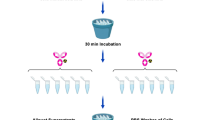Abstract
The effect of circulating antigen (human kappa light chains (LC)) on radioimmunoscintigraphy was examined in a normal rat model. Rats were implanted subcutaneously with kappa (test) and lambda (control) LC coupled to sepharose beads (500 μg LC/ml swollen gel). When 131I-labelled monoclonal antibody, K-1-21 was injected, clear images of specific antibody localisation to the kappa implant were seen 6 days later. The kappa implant: blood ratio (K:B) was 7.69±0.45, which represented an implant uptake of 2.52±0.20 percent injected dose per gram (%ID/g). When 131I-K-1-21 was preincubated with 125I-kappa LC at ratios of up to 1:10 antibody: antigen, (w/w) before injection; or if antigen was given daily by bolus injection or continuously infused via an osmotic pump, very clear specific images of antibody localisation to the kappa implant were still obtained. There was, however, a decline in the absolute uptake of label by the kappa implant. The greatest change was observed following continuous antigen infusion, when kappa implant uptake fell to 1.26±0.1 %ID/g. Nevertheless, the K:B ratio was still maintained at 6.8±0.2, due to increased clearance of antibody from the blood. Thus, in this case, where antigen and antibody might be expected to form small, soluble immune complexes, there was no major deleterious effect on radioimmunoscintigraphy.
Similar content being viewed by others
References
Axiak SM, Krishnamoorthy L, Guinan J, Raison RL (1987) Quantitation of free kappa light chains in the serum and urine using a monoclonal antibody based inhibition enzyme-linked immunoassay. J Immunol Methods 99:141–147
Barnett EV, Knutson DW, Abrass CK, Chia DS, Young LS, Liebling MR (1979) Circulating immune complexes: their immunochemistry, detection and importance. Ann Int Med 91:430–440
Bradwell AR, Fairweather DS, Dykes PW, Keeling A, Vaughan A, Taylor J (1985) Limiting factors in the localization of tumours with radiolabelled antibodies. Immunology Today 6:163–170
Chatal J-F, Fumoleau P, Saccavini J-C, Thedrez P, Curtet C, Bianco-Arco A, Chetanneau A, Peltier P, Kremer M, Guillard Y (1987) Immunoscintigraphy of recurrences of gynecological carcinomas. J Nucl Med 28:1807–1819
Dillman RO, Beauregard JC, Sobol RE, Rouston I, Bartholomew RM, Hagan PS, Halpern SE (1984) Lack of radioimmunodetection and complications associated with monoclonal anticarcinoembryonic antigen antibody cross-reactivity with an antigen on circulating cells. Cancer Res 44:2213–2218
Fawwaz RA, Wang TST, Srivastava SC, Hardy MA (1986) The use of radionuclides for tumor therapy. Nucl Med Biol 13:429–436
Goldenberg DM, Kim EE, DeLand FH, Bennett S, Primus FJ (1980) Radioimmunodetection of cancer with radioactive antibodies to carcinoembryonic antigen. Cancer Res 40:2984–2992
Hagan PL, Halpern SE, Chen A, Krishnan L, Frincke J, Bartholomew RM, David GS, Carlo D (1985) In vivo kinetics of radiolabeled monoclonal anti-CEA antibodies in animal models. J Nucl Med 26:1418–1423
Hnatowich DJ, Griffin TW, Kosciuczyk C, Rusckowski M, Childs RL, Mattis JA, Shealy D, Doherty PW (1985) Pharmacolinetics of an indium-111 labeled monoclonal antibody in cancer patients. J Nucl Med 26:849–858
Henze E, Kubel R, Waitzinger J, Buchler M, Adam WE, Beger HG (1987) Tumor scintigraphy with 131I anti CEA monoclonal antibodies and F(ab′)2 in colorectal cancer. Eur J Nucl Med 13:125–129
Kleist von S (1986) Tumor markers as target substances in the radioimmunological detection of malignancies. Nucl Med 25:125–127
Mannik M, Arend MP, Hall AP, Gilliland BC (1971) Studies on antigen-antibody complexes I. Elimination of soluble complexes from rabbit circulation. J Exp Med 133:713–739
Miller WT, Smith JFG (1983) Protein iodination using iodogen. Int J Appl Radiat Isot 34:639–641
Moldofsky PJ, Powe J, Hammon ND (1986) Monoclonal antibodies for radioimmunoimaging: current perspectives. In: Freeman LM, Weissman HS (eds) Nuclear Medicine Annual 1986. Raven Press, New York, pp 57–103
Primus FJ, Bennett SJ, Kim EE, De Land FH, Zahn MC, Goldenberg DM (1980) Circulating immune complexes in cancer patients receiving goat radiolocalizing antibodies to carcinoembryonic antigen. Cancer Res 40:497–501
Raison RL, Boux HA (1985) Conformation dependence of a monoclonal antibody defined epitope on free human kappa chains. Mol Immunol 22:1393–1398
Rhodes BA, Burke DJ, Breslow K, Reed K, Austin R, Burchiel SW (1983) Effects of circulating antigen on antibody localization in vivo. In: Burchiel SW, Rhodes BA (eds) Radioimmunoimaging and radioimmunotherapy. New York, Elsevier, pp 25–39
Sands H, Jones PL (1987) Methods for the study of the metabolism of radiolabeled monoclonal antibodies by liver and tumour. J Nucl Med 28:390–398
Walker KZ, Boux HA, Hayden GE, Goodnow CC, Raison RL (1985) A monoclonal antibody with selectivity for human kappa mycloma and lymphoma cells which has potential as a therapeutic agent. In: Klaus GGB (ed) Microenvironments in the lymphoid system. Plenum Press, New York, pp 833–841
Walker KZ, Seymour-Munn K, Keech FK, Axiak SM, Bautovich GJ, Morris JG, Basten A (1986) A rat model system for radioimmunodetection of kappa myeloma antigen on malignant B cells. Eur J Nucl Med 12:461–467
Walker KZ, Seymour-Munn K, Towsin JE, Axiak SM, Raison RL, Bautovich GJ, Morris J, Basten A (1988) Radioimmunolocalization and selective delivery of radiation in a rat model system: comparison of intact and fragmented antibody. Nucl Med Commun 9:517–526
Watanabe Y, Endo K, Koizumi M, Kawamura Y, Saga T, Sakahara H, Konishi J (1988) Effect of circulating antigen levels and antigen molecular size on the biodistribution of labeled monoclonal antibodies. (abstr.) J Nucl Med 29:890
Wilson MR, Wotherspoon JS (1988) A new microsphere-based immunofluorescence assay using flow cytometry. J Immunol Methods 107:225–230
Wochner RD, Strober W, Waldman TA (1967) The role of the kidney in the catabolism of Bence Jones proteins and immunoglobulin fragments. J Exp Med 26:207–221
Author information
Authors and Affiliations
Rights and permissions
About this article
Cite this article
McKay, D.R., Bautovich, G.J., Wilson, M.R. et al. The effect of circulating antigen on radioimmunodetection and monoclonal antibody localisation: studies in a normal rat model. Eur J Nucl Med 15, 313–320 (1989). https://doi.org/10.1007/BF00435472
Received:
Issue Date:
DOI: https://doi.org/10.1007/BF00435472




